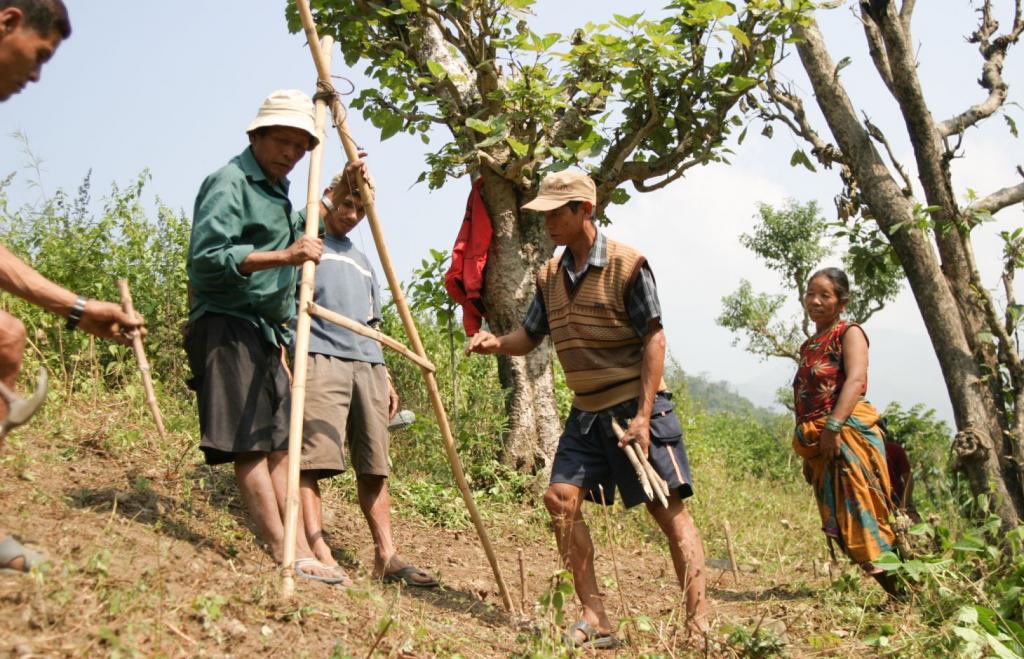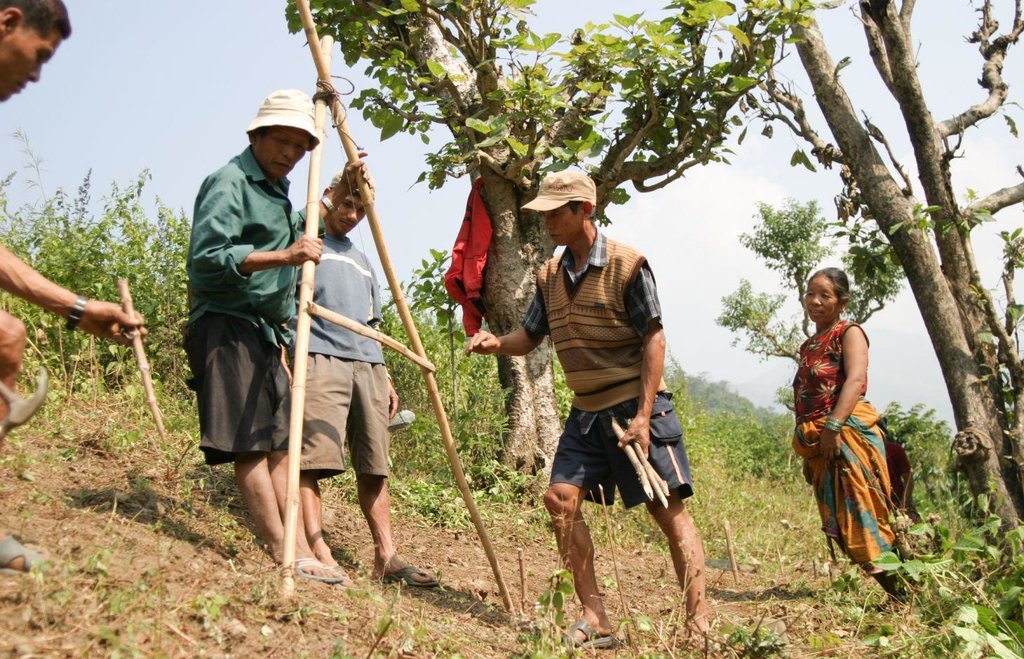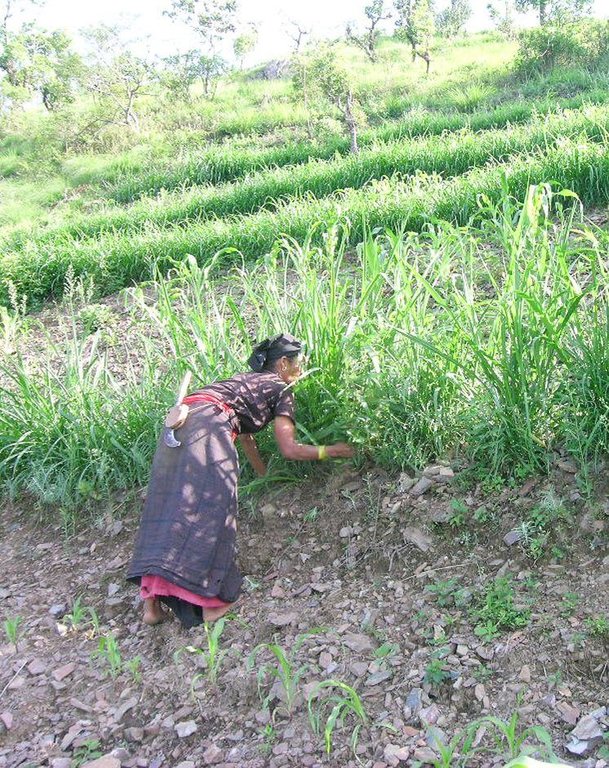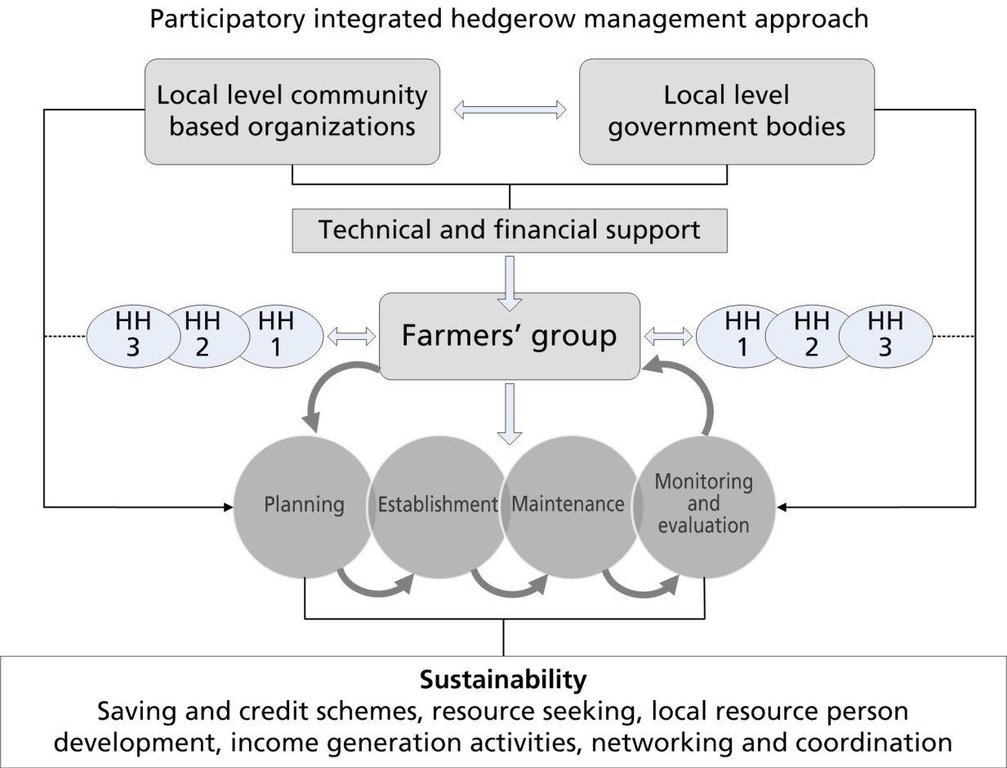Participatory hedgerow management [Nepal]
- Creación:
- Actualización:
- Compilador: Shreedip Sigdel
- Editor: –
- Revisor: Fabian Ottiger
Sahabhagitamulak ghasehar bewasthapan (Main Contributor: Gyanbandhu Sharma, LI-BIRD)
approaches_2530 - Nepal
Visualizar secciones
Expandir todo Colapsar todos1. Información general
1.2 Detalles de contacto de las personas de referencia e instituciones involucradas en la evaluación y la documentación del Enfoque
Especialista MST:
Nombre de la(s) institución(es) que facilitaron la documentación/ evaluación del Enfoque si fuera relevante)
Local Initiatives for Biodiversity, Research, and Development (LI-BIRD) - NepalNombre de la(s) institución(es) que facilitaron la documentación/ evaluación del Enfoque si fuera relevante)
ICIMOD International Centre for Integrated Mountain Development (ICIMOD) - Nepal1.3 Condiciones referidas al uso de datos documentados mediante WOCAT
¿Cuándo se compilaron los datos (en el campo)?
01/03/2013
El compilador y la/s persona(s) de referencia claves aceptan las condiciones acerca del uso de los datos documentados mediante WOCAT :
Sí
1.4 Referencia/s al/los Cuestionario(s) de Tecnologías MST

Hedgerow technology [Nepal]
A technology that uses hedgerows to help establish terraces on sloping land; farmers learn improved methods to manage a cultivation practice that stabilizes the soil, enhances food production, and adds to on-farm cash income.
- Compilador: Shreedip Sigdel
2. Descripción del Enfoque MST
2.1 Breve descripción del Enfoque
Hedgerow technology can be introduced through the joint participation of farmers, scientists, and related stakeholders. The whole community works together at all stages, including designing, planning, implementation, monitoring and evaluation, and scaling up.
2.2 Descripción detallada del Enfoque MST
Descripción detallada del Enfoque MST:
Aims / objectives: Communities can establish better hedgerows by supplementing the traditional knowledge that they have employed for generations with scientific knowledge through a participatory process where both groups are involved in every step of planning, designing, and implementation. This approach recognizes the validity of the local knowledge that farmers have about their land and supplements it with scientific techniques to facilitate the implementation of methods which will yield better results sooner.
Methods: Hedgerow technology can be implemented by forming farmers' groups and using a participatory approach. This technology has the potential to be scaled up and applied on a broader scale. The steps for sharing labour and know-how to establish hedgerows can be summarized as follows:
• Capacity is strengthened through discussions with technical persons.
• Farmers, technical persons, and related stakeholders work together to come up with plans that make the best use of both the farmers’ indigenous knowledge on how to form hedgerows and their understanding of the landscape, and scientific knowledge, for designing and planning.
• The hedgerows are established by the farmers as per the consensual plan.
• Some farmers are designated to periodically inspect the hedgerows and to perform maintenance as needed.
• The technology is scaled up by farmers who disseminate the learning to other farmers through extension and knowledge sharing at different fora.
Stages of implementation: Farmers, technical persons, and related stakeholders were all involved at every stage. In addition, LI-BIRD, local community-based organizations, and other related stakeholders such as the district forest office and the district agriculture office were on hand to support the farmers' group by offering technical and financial resources. The farmers' groups had a vested interest in this approach and demonstrated their commitment by: generating funds from a savings and credit scheme and conducting income generating activities. They also worked to establish effective linkages and to coordinate with related stakeholders to obtain resources which would ensure that the group would be self-reliant in the long run. The involvement of a wide range of participants will ensure that the technology is not only effective but that it is also sustainable. Moreover, when neighbouring communities see how successful this approach can be, it is hoped that they also will adopt the technology.
2.3 Fotos del Enfoque
2.5 País/ región/ lugares donde el Enfoque fue aplicado
País:
Nepal
Especifique más el lugar :
Gorkha, Tanahu District
2.7 Tipo de Enfoque
- proyecto/ basado en un programa
2.8 Propósitos/ objetivos principales del Enfoque
The Approach focused mainly on SLM with other activities (Income generation)
The objective of this approach was to introduce the technology through participatory planning, designing, and implementation by integrating farmers’ knowledge and experiences in the process.
The SLM Approach addressed the following problems: This approach addressed a few of the major problems in the area. The outstanding problems were:
• poor technical knowledge,
• lack of group efforts,
• lack of cash for investment,
• poor access to service providers,
• inadequate use made of farmers' traditional knowledge,
• inadequate knowledge resources, and
• poverty and poor social cohesiveness.
2.9 Condiciones que facilitan o impiden la implementación de la/s Tecnología/s aplicadas bajo el Enfoque
disponibilidad/ acceso a recursos y servicios financieros
- impiden
Farmers had insufficient financial resources to implement the technology
Treatment through the SLM Approach: Farmers learned how to apply for resources from different related stakeholders and they also learned how to generate cash from their own group using savings and credit schemes.
entorno institucional
- impiden
Farmers had no formal institutional mechanisms and also had no capacity to run their institutions
Treatment through the SLM Approach: Farmers learned how to form a formal group and also improved their capacity to run their institutions
marco de trabajo legal (tenencia de tierra, derechos de uso de tierra y agua)
- impiden
The existing land ownership, land use rights / water rights hindered a little the approach implementation
conocimiento de MST, acceso a apoyo técnico
- impiden
Farmers had low technical knowledge
Treatment through the SLM Approach: Farmers shared their know-how and also learned from scientists, other farmers and related stakeholders
3. Participación y roles de las partes interesadas involucradas
3.1 Partes interesadas involucradas en el Enfoque y sus roles
- usuarios locales de tierras/ comunidades locales
- especialistas MST/consejeros agrícolas
- ONG
LI-BIRD
- gobierno local
- gobierno nacional (planificadores, autoridades)
Si varias partes interesadas estuvieron involucradas, indique la agencia principal:
Specialists and land users. During the design process, specialists organized on-farm visits and exposure visits. The plan was prepared jointly by the land users and the specialists who used each others' expertise.
3.2 Involucramiento de los usuarios locales de tierras/ comunidades locales en las distintas fases del Enfoque
| Involucramiento de los usuarios locales de tierras/ comunidades locales | Especifique quién se involucró y describa las actividades | |
|---|---|---|
| iniciación/ motivación | pasivo | At the beginning, the land users were mostly passive because they lacked information on sloping land management. |
| planificación | interactivo | Land users were actively involved in the planning stage and they incorporated feedback from other stakeholders to finalize the action plan. During this phase they also prepared the land and the materials, and recruited the resource person needed to implement the technology |
| implementación | auto-movilización | Land users were involved in the implementation phase mobilizing their group members and shared the new technical knowledge that they had acquired. |
| monitoreo y evaluación | interactivo | Land users and other stakeholders remained actively involved throughout the different stages of monitoring and evaluation. |
| Research | apoyo externo | Land users were actively involved in research work to test and validate the approach. |
3.3 Flujograma (si estuviera disponible)
3.4 La toma de decisiones en la selección de Tecnología(s) MST
Especifique quién decidió la selección de las Tecnología/ Tecnologías a implementarse:
- principalmente usuarios de tierras con el apoyo de especialistas MST
Explique:
Both farmers and specialist were involved in on-farm visits to assess the condition of the land; farmers attended seminars to acquire new knowledge and they also used this opportunity to share their own knowledge. Farmers and specialists together selected the technology.
Decisions on the method of implementing the SLM Technology were made by mainly by land users supported by SLM specialists
4. Apoyo técnico, fortalecimiento institucional y gestión del conocimiento
4.1 Construcción de capacidades / capacitación
¿Se proporcionó la capacitación a usuarios de tierras/ otras partes interesadas?
Sí
Especifique quién fue capacitado:
- usuarios de tierras
- personal de campo/ consejeros
- Local Resource Person
Forma de capacitación:
- de agricultor a agricultor
- áreas de demostración
Temas avanzados:
This approach provided training on hedgerow technology and group mobilization to enhance the capacity of land users, field staff, and local resource persons. Site visits to the demonstration areas were also organized for the land users.
4.2 Servicio de asesoría
¿Los usuarios de tierras tienen acceso a un servicio de asesoría?
Sí
Especifique si servicio proporcionado se realizó:
- en centros permanentes
Describa/ comentarios:
Name of method used for advisory service: Group Mobilization Method; Key elements: networking and coordination of farmers' groups with district level line agencies such as the district forest office, the district agriculture office, the district livestock office, and other relevant stakeholders for learning and sharing of information.
4.3 Fortalecimiento institucional (desarrollo institucional)
¿Se establecieron o fortalecieron instituciones mediante el Enfoque?
- sí, un poco
Especifique el nivel o los niveles en los que se fortalecieron o establecieron las instituciones:
- local
Especifique el tipo de apoyo:
- construcción de capacidades/ entrenamiento
Proporcione detalles adicionales:
Trainings and sessions on capacity building were provided to the land users
4.4 Monitoreo y evaluación
¿El monitoreo y la evaluación forman parte del Enfoque?
Sí
Comentarios:
bio-physical aspects were regular monitored by project staff, land users through observations; indicators: The land users and project staff made regular observations of sediment deposition rates after the intervention.
technical aspects were regular monitored by project staff, land users through observations; indicators: The land users and project staff made regular observations on the formation of terraces and control of erosion.
socio-cultural aspects were regular monitored by project staff, land users through observations; indicators: The land users and project staff regularly observed sociocultural impacts
economic / production aspects were regular monitored by project staff, land users through observations; indicators: The land users and project staff regularly observed the extent to which the income of the land users changed.
area treated aspects were regular monitored by government, land users through measurements; indicators: The land users and government staff monitored the coverage of the technology.
no. of land users involved aspects were regular monitored by project staff, land users through observations; indicators: Regular observations were made by the land users and project staff on how many land users were adopting the technology.
management of Approach aspects were regular monitored by project staff, land users through observations; indicators: The land users and project staff regularly observed how well the group functioned together and how well they linked with stakeholders
There were few changes in the Approach as a result of monitoring and evaluation: Monitoring brought few changes; farmers used the information gathered during monitoring of on-farm demonstration to help them select the species they preferred but the technology remained the same.
There were no changes in the Technology as a result of monitoring and evaluation
4.5 Investigación
¿La investigación formó parte del Enfoque?
Sí
Especifique los temas:
- tecnología
Proporcione detalles adicionales e indique quién hizo la investigación:
On-farm technical research was a part of the approach applied by land users, specialists, and relevant stakeholders who were involved in hedgerow technology trials.
Research was carried out on-farm
5. Financiamiento y apoyo material externo
5.1 Presupuesto anual para el componente MST del Enfoque
Comentarios (ej. fuentes principales de financiamiento/ donantes principales):
Approach costs were met by the following donors: national non-government: 20.0%; local government (district, county, municipality, village etc): 10.0%; local community / land user(s): 70.0%
5.2 Apoyo financiero/material proporcionado a los usuarios de tierras
¿Los usuarios de tierras recibieron financiamiento/ apoyo material para implementar la Tecnología/ Tecnologías? :
Sí
Si respondió sí, especifique el tipo o los tipos de apoyo, condiciones y proveedor(es) :
LI-BIRD provided some support.
5.3 Subsidios para insumos específicos (incluyendo mano de obra)
Si la mano de obra de usuarios de tierras fue un insumo sustancial, ¿fue:
- voluntario?
5.4 Crédito
¿Se proporcionó crédito bajo el Enfoque para actividades MST?
No
6. Análisis de impacto y comentarios de conclusión
6.1 Impactos del Enfoque
¿El Enfoque ayudó a los usuarios de tierras a implementar y mantener Tecnologías MST?
- No
- Sí, un poco
- Sí, moderadamente
- Sí, mucho
This approach helped to stabilize the fragile hill slopes.
¿El Enfoque empoderó a grupos en desventaja social y económica?
- No
- Sí, un poco
- Sí, moderadamente
- Sí, mucho
The capacity of marginal ethnic groups increased; they learned how local institutions function and felt empowered to seek resources from their service providers.
Did other land users / projects adopt the Approach?
- No
- Sí, un poco
- Sí, moderadamente
- Sí, mucho
This approach was adopted by adjoining villagers and scaled up gradually in Dhading, Chitwan, Nawalparasi, and Makwanpur Districts. According to preliminary information, at least 450 households have now adopted this approach for sustainable land management.
Did the Approach lead to improved livelihoods / human well-being?
- No
- Sí, un poco
- Sí, moderadamente
- Sí, mucho
This approach helped to improve the livelihood status of the land users by helping to diversify their options for income generation and skills development.
Did the Approach help to alleviate poverty?
- No
- Sí, un poco
- Sí, moderadamente
- Sí, mucho
After the implementation of this approach, land users could earn cash income and learned how to increase their capacity to implement income generating activities which would enhance their livelihoods.
6.2 Motivación principal del usuario de la tierra para implementar MST
6.3 Sostenibilidad de las actividades del Enfoque
¿Pueden los usuarios de tierras sostener lo que se implementó mediante el Enfoque (sin apoyo externo)?
- incierto
Si respondió no o incierto, especifique y comente:
Individual land users were enthusiastic to implement the approach and to take it further. Land users who are shifting cultivators, and who typically have no land ownership, are slower to embrace the approach.
6.4 Fortalezas/ ventajas del Enfoque
| Fuerzas/ ventajas/ oportunidades desde la perspectiva del compilador o de otra persona de referencia clave |
|---|
| Sustained capacity building (How to sustain/ enhance this strength: Continue to build strong links and coordinate with government line agencies) |
| Improved access to services providers helped to enhance their capacity to cope with adverse conditions (How to sustain/ enhance this strength: Continue to build and maintain contact with government line agencies) |
| Local institutions were strengthened (How to sustain/ enhance this strength: Established formal institutions and help to sustain them) |
| Land users actively participated and took ownership (How to sustain/ enhance this strength: Continue capacity building and training. At present the government is initiating programmes with leasehold forest groups in Gorkha and Tanahu Districts that encourages the establishment hedgerows è Work to mainstream the approach within government programmes) |
| Collaboration helped land users to sustain their efforts (How to sustain/ enhance this strength: Continue to build a sense of community between land users) |
6.5 Debilidades/ desventajas del Enfoque y formas de sobreponerse a ellos
| Debilidades/ desventajas/ riesgos desde la perspectiva del compilador o de otra persona de referencia clave | ¿Cómo sobreponerse a ellas? |
|---|---|
| Difficult to develop common understanding | Organized regular learning and sharing to develop common understanding |
|
Farmers have only a limited understanding of the skills needed |
Continue to strengthen farmers' groups and continue to mobilize through sharing and learning |
| The approach is resource intensive. | Promote savings and credit schemes with farmers' groups. Mobilize farmers' groups so that they can petition other groups and line agencies for resources. |
| Time consuming | Work with land users to improve their time management and their ability to plan future activities and delegate responsibilities |
| Few farmers participated during the initial stages | Conduct awareness raising activities and promote activities that give some tangible benefits in the short term. |
7. Referencias y vínculos
7.1 Métodos/ fuentes de información
- visitas de campo, encuestas de campo
- entrevistas con usuarios de tierras
7.2 Referencias a publicaciones disponibles
Título, autor, año, ISBN:
Building on partnership approaches in participatory identification of integrated agricultural technological packages suitable for sloping land areas (unpublished), Regmi, BR; Aryal, KP; Shrestha, PK; Tamang, BB (2003)
¿Dónde se halla disponible? ¿Costo?
LI-BIRD
Vínculos y módulos
Expandir todo Colapsar todosVínculos

Hedgerow technology [Nepal]
A technology that uses hedgerows to help establish terraces on sloping land; farmers learn improved methods to manage a cultivation practice that stabilizes the soil, enhances food production, and adds to on-farm cash income.
- Compilador: Shreedip Sigdel
Módulos
No se hallaron módulos






